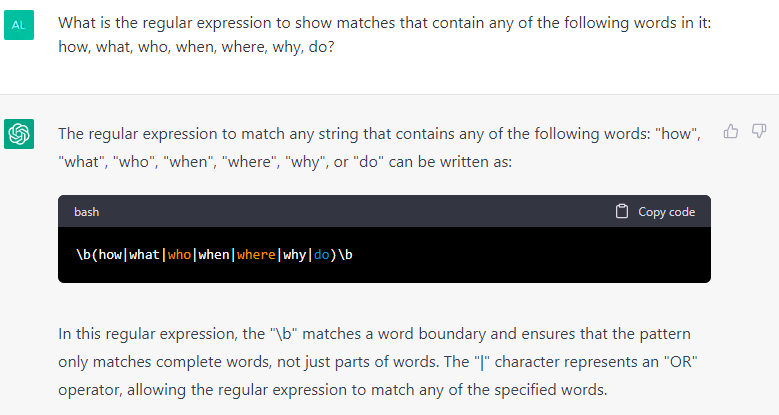Introduction
As a language model trained by OpenAI, ChatGPT is a powerful tool that has various use cases in the world of search engine optimization (SEO). It can help SEO professionals automate repetitive tasks, generate creative ideas, and even come up with content ideas. However, like any other tool, it has both its best and worst use cases. In this blog post, we will discuss some of the best and worst use cases of ChatGPT for SEO based on the data provided.
Best Use Cases
1. Regex
Regular expressions or regex are used to find patterns within text. ChatGPT is great at creating regex patterns. For instance, you can ask ChatGPT to help you find keywords that are phrased as questions in Search Console. By using regex, ChatGPT can find the matches that contain any of the following words: how, what, who, when, where, why, and do. Armed with this information, you can work on bringing those informational keywords from page 2 to page 1 of Google.
Step 1: Go to ChatGPT and write “What is the regular expression to show matches that contain any of the following words in it: how, what, who, when, where, why, do?”

Step 2: Copy this code “\b(how|what|who|when|where|why|do)\b” and go to Search Console, paste that custom regex into the query filter.

Step 3: Set the Positions filter to greater than 10.

2. Full Out Automation
ChatGPT can help you create full automation, making your work more efficient. For example, if you are working on a link-building campaign, you can ask ChatGPT to create a function called find email in Google Appscripts to return a person’s email address using Hunter.io’s “Email Finder” API. This can save you time and effort compared to going through each email one by one.
Step 1: Go to ChatGPT and write “Using Hunter.io’s “Email Finder” API, write a function called findEmail in Google Appscripts to return a person’s email address. If no email exists, then return “They don’t want to be contacted”. I will provide the first name, last name, and domain name. Btw, my API key is this……… Go!”

Step 2: Now go to Google Sheets > Extension > App Script and paste the code there.

Step 3: Now go to the Email column and write “=findEmail(A2,B2,D2)” you will find the email address of that person.

3. Click-Worthy Titles
Coming up with click-worthy titles can be challenging, but ChatGPT can help. By asking ChatGPT to write 10 click-worthy titles for your blog post on a topic, you can get creative ideas that will grab readers’ attention. It can even frontload keywords to match search intent and add personality to your titles.

4. Quick Outlines
Creating quick outlines can help your creative juices flow, and ChatGPT can help with that. By giving ChatGPT a topic, it can help you generate an outline for your blog post or article. This can help you organize your thoughts and create a more structured piece of content.

Worst Use Cases
1. AI-Driven Keyword Research
While ChatGPT is excellent at generating long-tail or “easy-to-rank-for” queries, it’s not the best tool for keyword research. Keyword difficulty mostly comes down to backlinks, SERP competition, and the actual content itself. ChatGPT cannot browse the web, so it cannot provide you with accurate keyword research.

2. Long-Form Content Creation
While ChatGPT can generate high-quality content, it’s almost always going to come out as boilerplate content. This means that the same content will be generated by other users, making it unoriginal. It can also lack the depth and specificity that humans can provide. If you want to create long-form content, it’s best to write it yourself or hire a professional writer who can add a personal touch and unique insights to your content.
Another downside of relying solely on ChatGPT for long-form content creation is that it doesn’t have the same level of creativity and nuance as a human writer. It may struggle to come up with unique and original ideas or angles, and its language may lack the tone, voice, and personality that human readers can connect with.
That said, ChatGPT can still be a valuable tool for content creation, especially when used in conjunction with human writers. It can help generate ideas, provide research and insights, and even assist with drafting outlines or individual sections of content. The key is to use ChatGPT as a supplement to, rather than a replacement for, human expertise and creativity.
Conclusion
In conclusion, ChatGPT can be a powerful tool for SEO when used appropriately. Its strengths in areas like regex and automation can help streamline tasks and increase efficiency, while its ability to generate click-worthy titles and provide quick outlines can be useful for idea generation. However, its limitations in areas like AI-driven keyword research and long-form content creation should be taken into consideration, and it should always be used in conjunction with human expertise and creativity.

Hello, I’m Ali Raza, the brain behind Digital Realm Trends.
Hailing from the vibrant world of digital marketing, I’ve honed my skills over years. Based on my experience, I’m here to unravel the complexities of digital marketing, analytics and paid marketing, crafted for individuals like you. Join me in uncovering the power of digital marketing tools and strategies, fueled by experimentation and insights.




